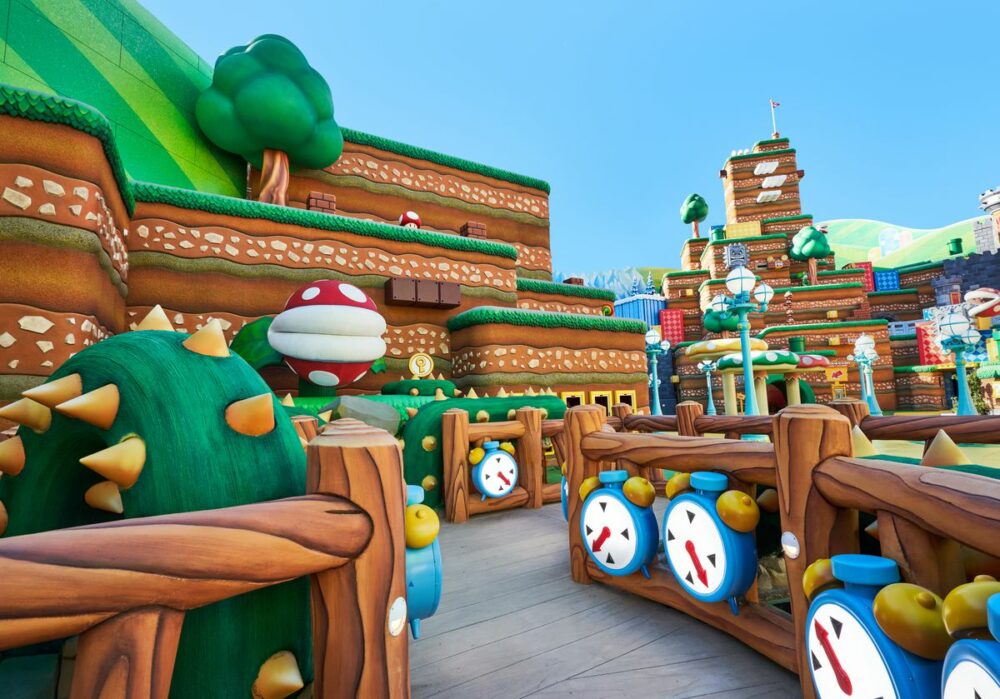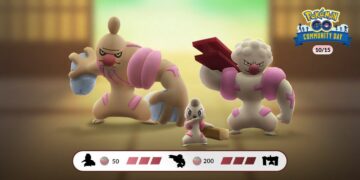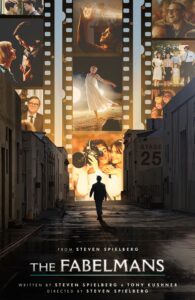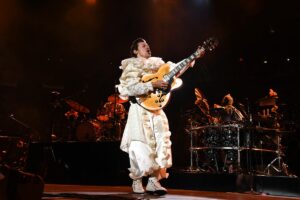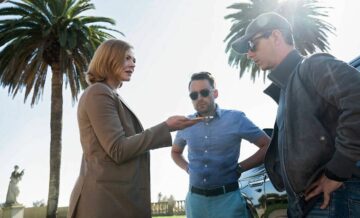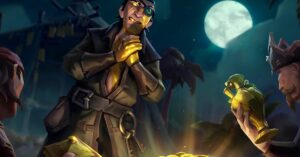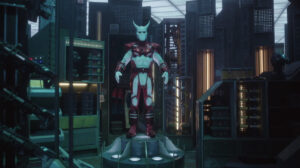Super Nintendo World, which opens Friday at Universal Studios Hollywood, is a wholly unique and unforgettable new addition to the theme park. It brings Nintendo’s colorful worlds to life, allowing visitors to move through the space — speckled with Thwomps, stacks of Goombas, spinning Koopa shells, and other iconic characters — as if they were Mario and his friends. Walking through the land, tapping coin blocks, and trying out the attractions felt like revisiting childhood memories.
It is also an unprecedented addition to Universal Studios — and to the makeup of amusement parks more broadly, which have historically focused on translating films to attractions and physical spaces. Nintendo, of course, is no stranger to innovation, having created some of the most beloved, unique, and enduring video games and characters of all time. The park is a testament to this legacy, and a new space for fans to play in.
Veteran game designer Shigeru Miyamoto, now a representative director and fellow at Nintendo, was heavily involved with the creation of the park. Miyamoto’s creative vision has long been at the heart of Nintendo, as the creator of Mario, The Legend of Zelda, Donkey Kong, and more. His unique approach to game design served to redefine what was possible in the industry. It would not be an overreach to say that Miyamoto pioneered the contemporary concept of game design, by making art and player experience priorities.
After four decades developing video games, Miyamoto appeared to be scaling back his involvement with contemporary Nintendo games. But this was only the case because Miyamoto was in fact focusing so much of his energy on Super Nintendo World, according to Shinya Takahashi. Director and senior managing executive officer at Nintendo, Takahashi’s own producer credits span decades, covering some of Nintendo’s most famous franchises, like Brain Age, Kirby, and Pikmin.
Polygon spoke with Miyamoto and Takahashi, via interpreters, about the experience of bringing Mario’s world to life in a theme park, and what the future holds for Nintendo.
Bringing Mario’s world to life
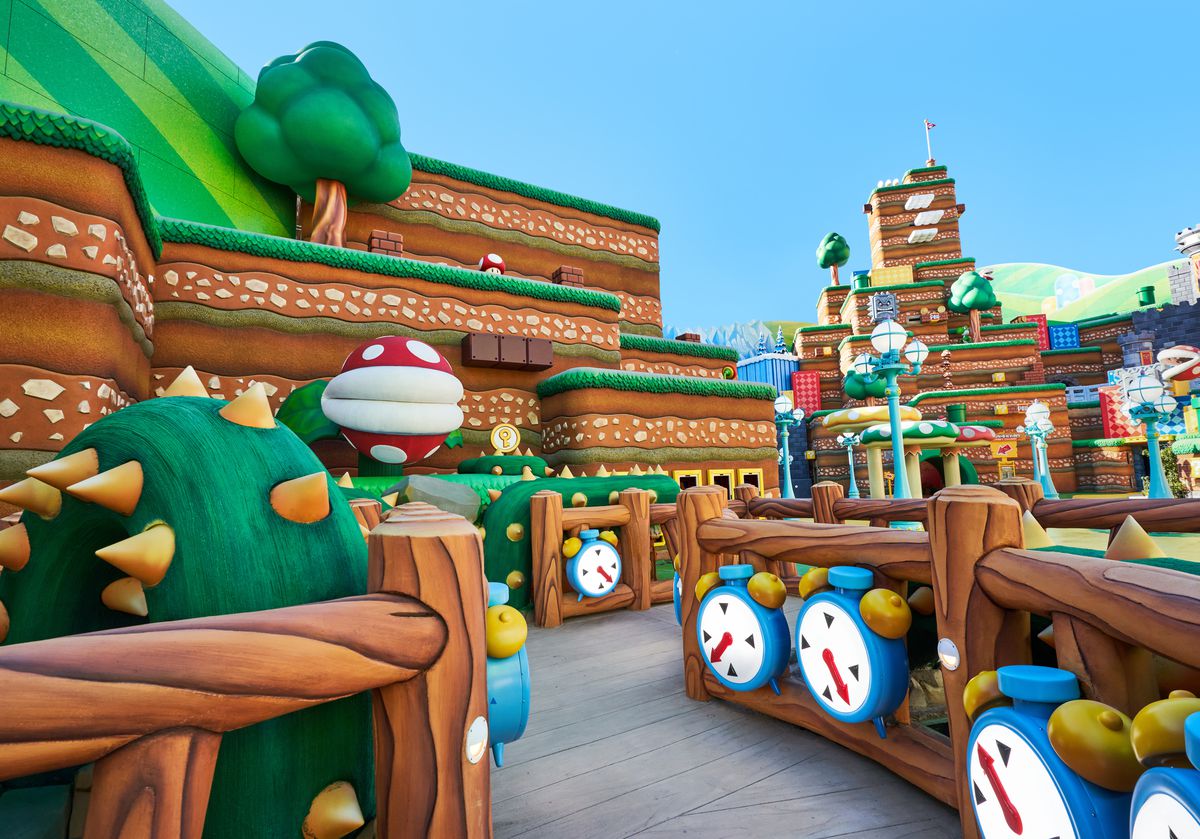
After years of designing and producing Mario games in the digital realm, Miyamoto and Takahashi had to consider how to translate the interactive virtual space into a real-world one. Some of these elements were more straightforward and clear, like allowing visitors to hit a coin block. But designing the park also involved embracing the unknown.
“There’s a little bit of uncertainty about what’s going to be at the end of this: Is this going to be something that is worth all this effort?” Takahashi said. “When we were able to actually interact with, say, the question block for the first time and actually hit it — and get that feeling, and the coin sound, knowing that we were able to create something that does bring that interactivity to life — that was where we had that first sense of, This is going to work out for us.”
“When I think of parks, I would think of an actual park in your neighborhood,” Miyamoto said. “Maybe there’s a fountain and you walk around barefoot in it, or there’s a hill and you just roll down. That’s what I imagined. Although I would love to have that available here, there’s safety concerns to take into consideration. So while we guarantee safety, we provided ways of interacting with the park, like the question block that you can hit to get points.”
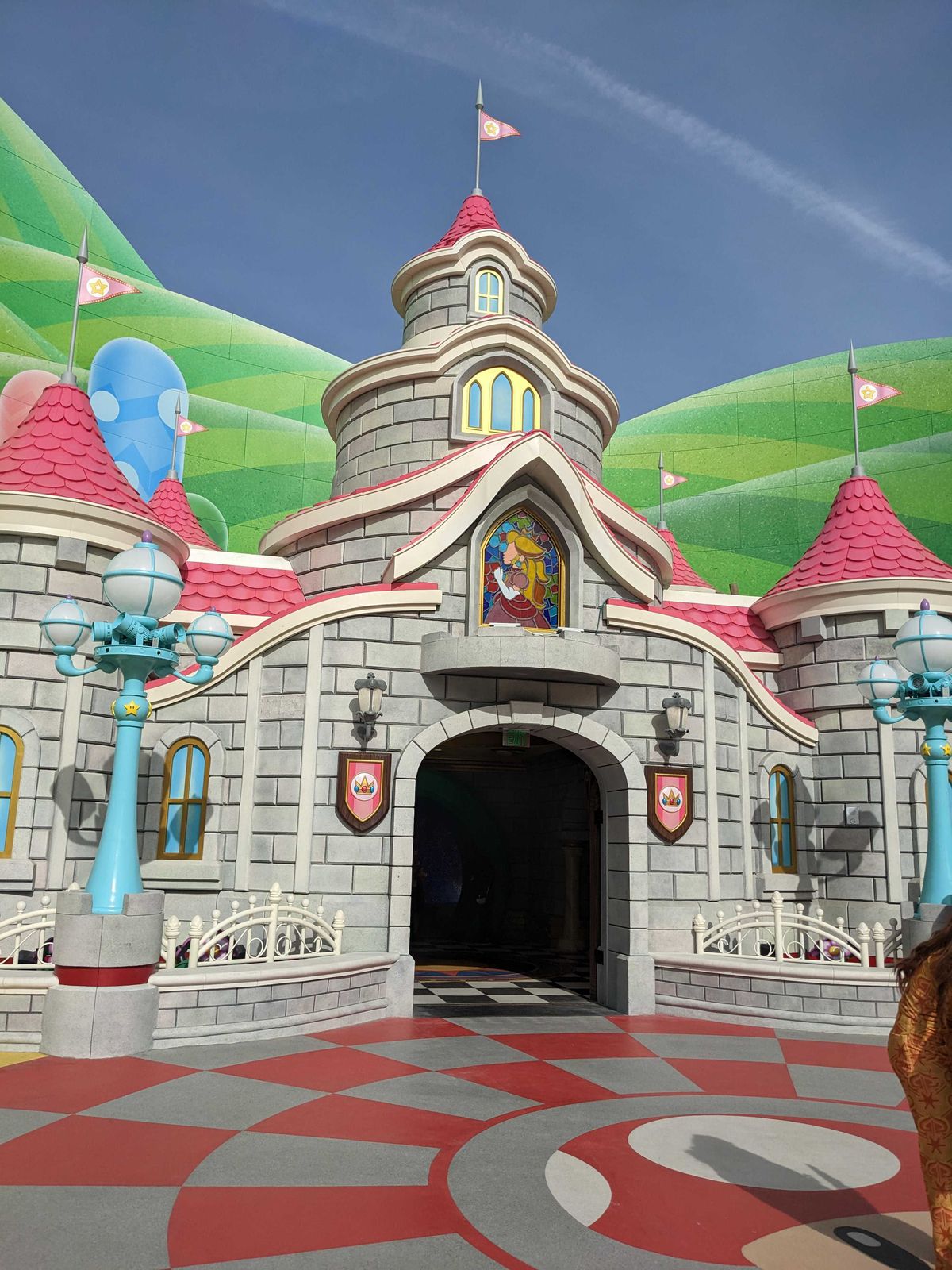
Chief among these challenges was designing unfamiliar elements, like what the interior of a Warp Pipe looks and sounds like. This is still something the team is working on getting just right, according to Miyamoto. And it’s something that they iterated on, since the original Super Nintendo World park first opened at Universal Studios Japan in Osaka in 2020.
“In reality, we ended up building a big building, as you can see, and I wanted to climb it. But there’s experiences that happen in real life that don’t happen in video games,” Miyamoto said. “For example, in Mario when you’re going into, say, a dungeon, in the game it’s just a scene switch. But in real life, there is a transition phase that you have to go through.” This is also how Miyamoto describes the Warp Pipe’s role in helping visitors move into a new space. It is “an entryway or transition phase from the daily life into the Mushroom Kingdom.”
This attention to detail is clear in every aspect of the park. Walking through the Warp Pipe entrance, as the familiar sound effect plays, is immediately transportive. When you emerge, the space is saturated with color and detail. It’s like being inside a fishbowl, with buildings and set pieces multiple stories high all around, and characters in constant motion. Everywhere you look is packed with visual information. During my visit I spent a significant amount of time just sitting in the middle, taking it all in, feeling as though I could empathize with Mario after guiding him along digital adventures all these years.
“In the game world there’s Yoshi and Koopa Troopas, they’re always moving, so we wanted to make sure that they were always moving in real life as well,” Miyamoto said. “There’s concerns like ‘Is it actually going to be convincing? Is it actually going to turn out the way we want it to?’ And after seeing all of these elements come through, and actually having them all together in one place and seeing them function, I had this moment where the landscape I’m seeing really links up with my game experience that I’ve had in the past. And really it synced up and matched. And realizing all of the elements have come together to make this possible — [it] was a moment.”
In other parts of Universal Studios Hollywood there isn’t that same kind of mirage, or sense that you’re inside an entirely new universe. You’re clearly in an amusement park, enjoying various attractions and staged moments with movie characters. In Super Nintendo World, the illusion really never breaks. Hidden hallways beckon guests in — often these passages are tucked by the exits of larger attractions in order to foster exploration. Even the seating around this section of the park is designed to look like a cropping of mushrooms under the shade of larger mushrooms.
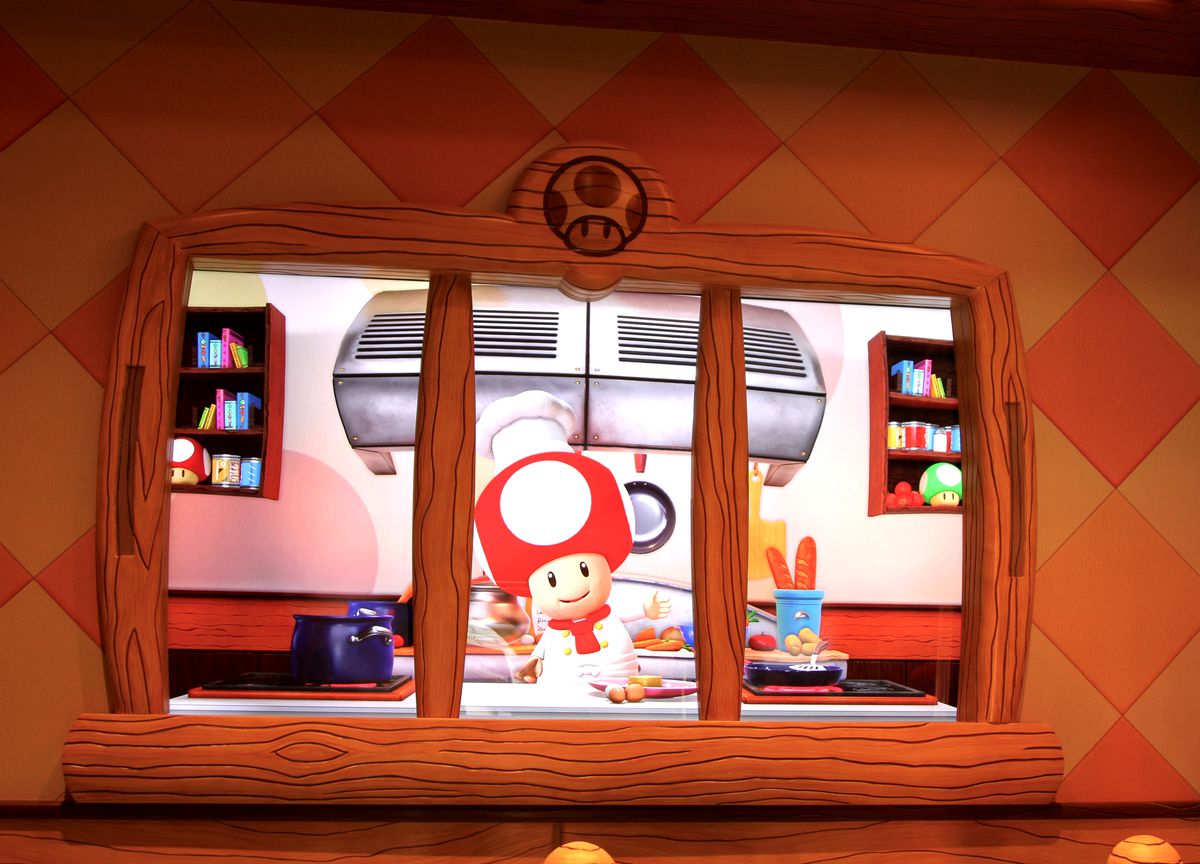
The Toadstool Cafe, which serves adorable themed food, like a Mario burger or question block tiramisu, is filled with “windows” that show Toads hard at work in the kitchens or frolicking outdoors in Toad Village. When you enter, Chef Toad greets you and welcomes you to enjoy the fruits of his labor. In the Illumination part of the park you can buy a Minion-themed soda cup and straw. In Super Nintendo World, Toads exist and are preparing your meal.
“Another example, of course, is Mario Kart: Bowser’s Challenge. This is an experience you can’t have just on a video game console,” Takahashi said. “Through the use of AR and other technologies, we are able to leverage our own experiences to create something, again, that moves beyond the experience you would have in just the game.”
And though the park is designed to be welcoming to newcomers, it’s also full of Easter eggs that longtime fans can discover.
“There was discussion about adding other IPs in there, like Splatoon. But instead of having our focus scattered, we thought it would be easier to start with something focused,” Miyamoto said. “That’s why we ended up starting with Mario. However, because of that backdrop, if you notice, you might be able to find some other IP sprinkled in the world. So I encourage you to take a look.”
A place where families can play together
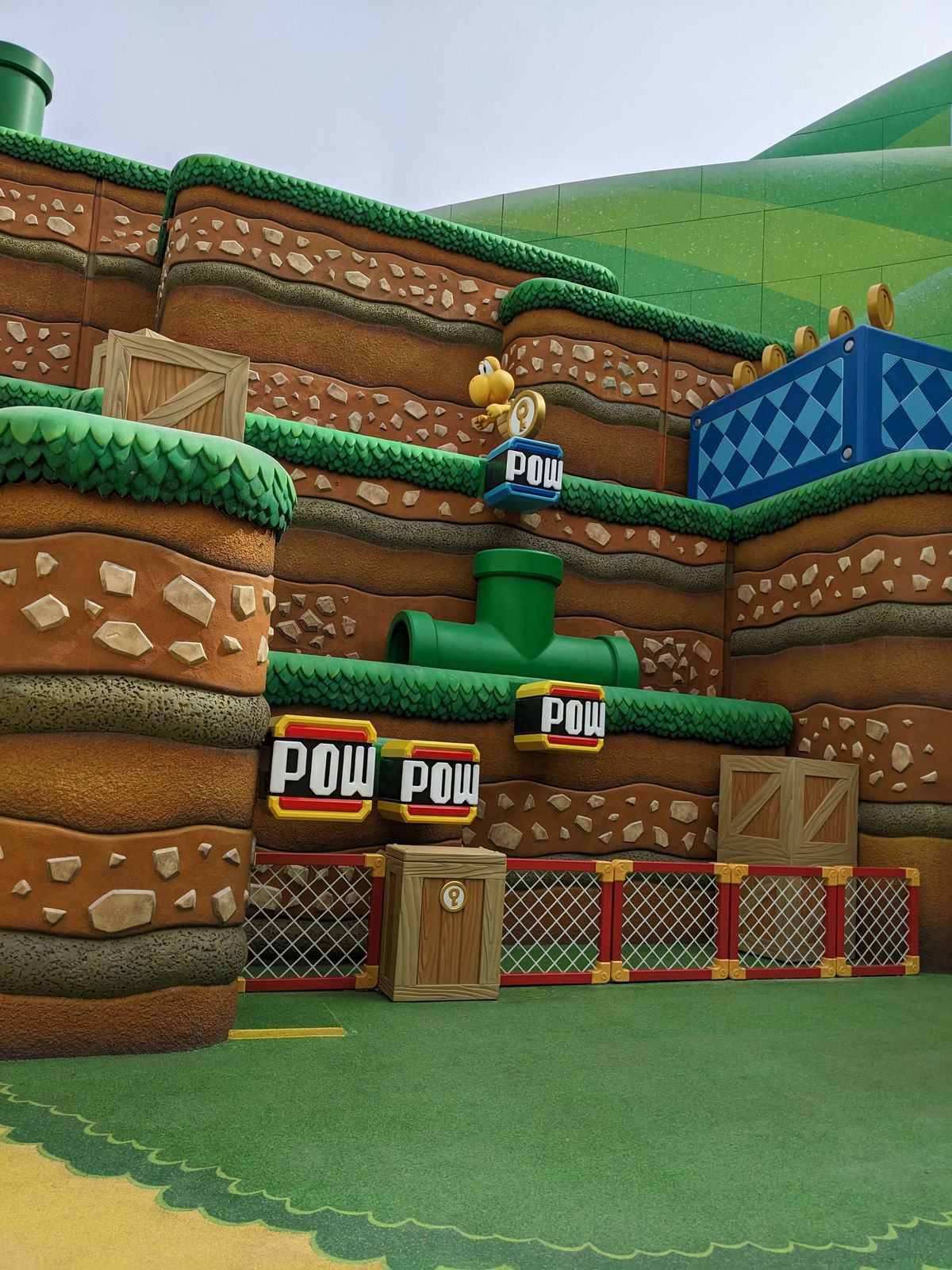
Super Nintendo World was also intentionally designed to encourage collaboration, for first-timers and seasoned fans alike. Interactive elements are everywhere; you can hardly walk a few paces without hearing the telltale tinkling of a coin block, and wondering how you can find it, too.
“As long as you make an experience that’s relatable and fun for fans to engage in, naturally kids will be able to have fun with that,” Miyamoto said. “When you go to other parks you might see the kids playing and then the parents are just kind of resting on the side. And that’s something that you observe there that you may not observe here.”
Super Nintendo World is designed like a game. Bowser has stolen Princess Peach’s Golden Mushroom, and it’s up to visitors to win it back by playing a series of three minigames, called “activities,” and a final boss battle. Visitors can buy a Power-Up Band, which tracks their progress, and also keeps count of coins received from Coin Blocks. Most of these “activities” are much easier to do with at least one partner — a Piranha Plant activity requires turning off multiple clocks, and I ended up making some new friends in order to beat it. It’s easy to imagine how a family would do this activity together, and how a child might see someone else play and feel encouraged to join in.
“For Nintendo, the idea of games is something that brings the family together in the living room to interact, as mentioned, like a connective tissue. And when we’re talking about games, it really just happens in the living room,” Miyamoto said. “This entire space can be used to do just that.”
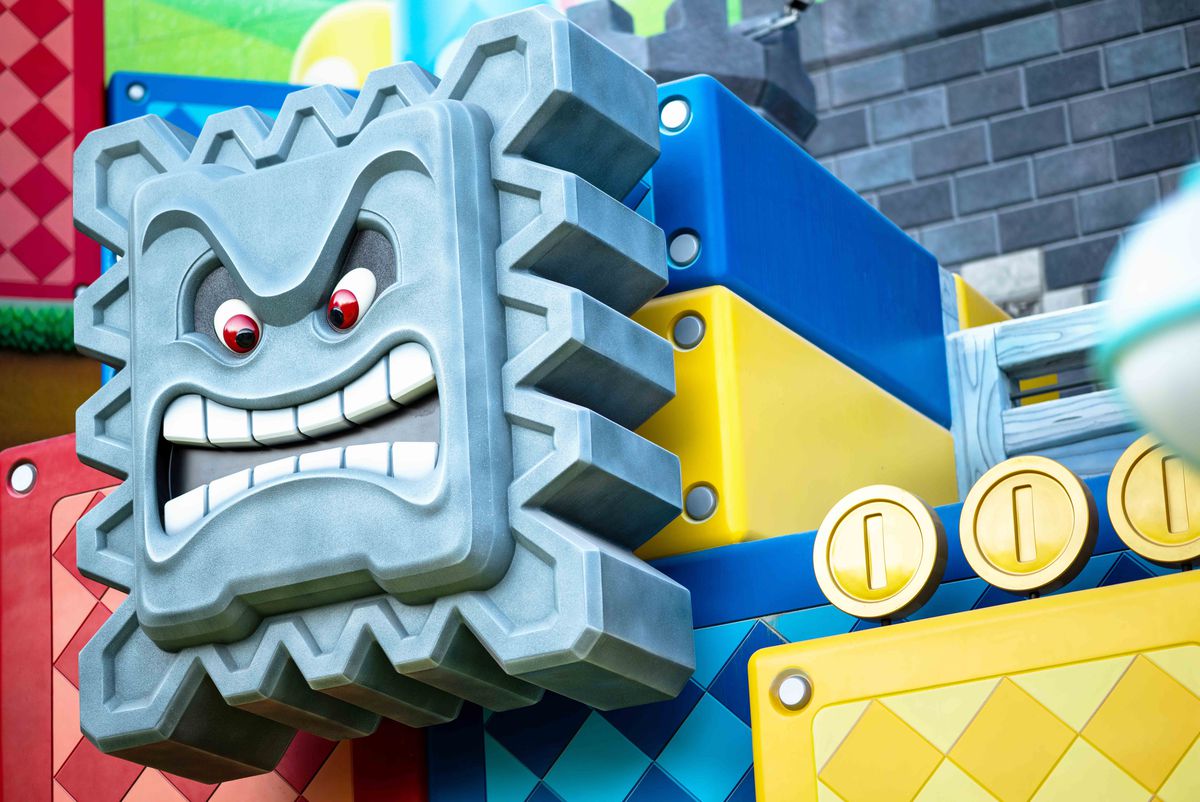
This is, ultimately, an extension of Nintendo’s core ethos, as a company dedicated to creating experiences that are family-friendly — and even more than that, bridging generational gaps by making something not just entertaining for children and adults, but a way for those groups to play together.
“We have those small children coming in who don’t know Mario, who haven’t played the games yet,” Takahashi said. “And then as we move up through these kids to their grandparents or their great-grandparents, Mario and Nintendo World, and Mario himself as a character in the franchise, can be that connective tissue that runs through those generations. That’s something I think we can look forward to achieving with this theme park.”
The future of Nintendo
Over the years, Nintendo has developed a reputation for introducing new ways of play, often through championing new gameplay technologies. This extends back to the Nintendo Entertainment System, with its extensive catalog of games, and through the era of the Wii, which made motion controls mainstream. The Nintendo Switch was another leap, giving people the option to play games on a television or via a handheld console well suited for playing anywhere.
But Miyamoto and Takahashi are careful not to characterize Nintendo as a company of cutting-edge technology, but one that prioritizes simplicity for the user. Technology is a key part of play, hand-in-hand with the ultimate goal of making games enjoyable for anyone to try.
“We, as a company, want to take the tech that’s available to us, and implement it in games in a way that is easy to use and easy to understand,” Takahashi said.
“I think we’re always looking for unique uses of technology,” Miyamoto said. “How we use that in a unique way, and then distill that into a product, is what I feel Nintendo is adept at. When Mario was created, it became popular and we thought that really Mario became popular because it was a fun game. And so we thought that for every introduction of new technology, Mario can then evolve alongside that. For every kind of hardware, we’ve had a new Mario, and in the same vein with the theme park, we have AR technology and Mario Kart that’s blended together to create this harmony of the actual physical backdrops that are in the physical space and the changing virtual backdrop that’s in front of the screen. And I think that’s something that has really made this experience a great one. Going back to Mario, for any future technology that comes out, we’ll assess whether that’s best suited for Mario and continue to evolve.”
Super Nintendo World is just the latest example of Mario’s — and Nintendo’s — evolution, a combination of innovation, technology, and pure fun. It’s Mario on his greatest adventure yet: real life.
- SEO Powered Content & PR Distribution. Get Amplified Today.
- Platoblockchain. Web3 Metaverse Intelligence. Knowledge Amplified. Access Here.
- Source: https://www.polygon.com/23604910/miyamoto-takahashi-super-nintendo-world-interview-mario
- 2020
- About
- according
- achieving
- activity
- ADDITION
- Adventure
- All
- All Time
- Allowing
- alongside
- Although
- among
- amount
- Another
- approach
- AR
- around
- Art
- as
- aspect
- attention
- available
- backdrop
- band
- Battle
- because
- BEST
- beyond
- BIG
- Bit
- block
- blocks
- Bowser
- Bridging
- bring
- bringing
- brings
- Building
- button
- buy
- case
- catalog
- challenges
- championing
- characterize
- characters
- child
- Children
- clearly
- Coin
- Coins
- collaboration
- colorful
- combination
- coming
- company
- concept
- Consider
- consideration
- Console
- contemporary
- continue
- controls
- convincing
- Core
- could
- course
- covering
- create
- created
- Creating
- creation
- Creative
- creator
- Credits
- cutting-edge
- decades
- dedicated
- Design
- designed
- designer
- designing
- detail
- developed
- developing
- digital
- Director
- discover
- Donkey Kong
- down
- During
- easier
- Effect
- effort
- Eggs
- elements
- embracing
- emerge
- encourage
- enduring
- energy
- engage
- Enter
- entertaining
- Entertainment
- entirely
- Entrance
- era
- Ethos
- Every
- Everywhere
- evolution
- Evolve
- Example
- executive
- Executive Officer
- experience
- Experiences
- exploration
- extension
- familiar
- families
- family
- fans
- filled
- films
- Final
- First
- first time
- Focus
- focused
- focusing
- food
- Forward
- Franchise
- Franchises
- Friday
- Friends
- front
- full
- fun
- function
- future
- game
- gameplay
- Games
- Gaming
- getting
- Giving
- Glass
- goal
- going
- great
- greatest
- greeting
- guarantee
- Hard
- Hardware
- Harmony
- having
- hearing
- heavily
- helping
- here
- hidden
- High
- historically
- Hollywood
- How
- How To
- HTTPS
- i
- idea
- image
- imagined
- immediately
- implement
- industry
- information
- Innovation
- INSIDE
- instead
- interact
- interacting
- interactive
- interactivity
- introduction
- involved
- involvement
- IP
- IT
- Japan
- join
- Key
- kids
- kind
- Kingdom
- Kirby
- KONG
- labor
- Land
- landscape
- larger
- latest
- legacy
- legend of zelda
- Leverage
- Life
- links
- Little
- living
- Long
- looking
- love
- Mainstream
- make
- makeup
- Making
- managing
- Mario
- Mario Kart
- May
- Middle
- might
- Mirage
- more
- move
- movie
- moving
- multiple
- New
- Nintendo
- Nintendo Switch
- Officer
- One
- opens
- Option
- order
- original
- osaka
- Other
- outdoors
- own
- Packed
- parents
- parks
- part
- partner
- Past
- People
- phase
- physical
- pioneered
- pipe
- place
- plato
- plato data intelligence
- platodata
- platogaming
- play
- player
- Playing
- Points
- Polygon
- Popular
- positioned
- possible
- PoW
- preparing
- Princess Peach
- producer
- Product
- Progress
- question
- Real
- real world
- Reality
- realm
- received
- representative
- requires
- right
- role
- Roll
- room
- Safety
- Said
- scaling
- Screen
- seasoned
- section
- senior
- sense
- Series
- serves
- set
- Shade
- Shigeru Miyamoto
- significant
- Sitting
- small
- So
- something
- Space
- spaces
- start
- Starting
- still
- stolen
- Stories
- straightforward
- stranger
- super
- Super Nintendo
- Switch
- system
- Take
- taking
- talking
- Team
- tech
- Technologies
- Technology
- television
- testament
- The
- The Game
- The Legend of Zelda
- the world
- theme
- Through
- time
- together
- top
- transition
- turning
- ultimate
- uncertainty
- under
- Understand
- unfamiliar
- unique
- Universal
- universe
- unknown
- unprecedented
- up
- us
- User
- various
- via
- Video
- video games
- View
- Village
- Virtual
- vision
- visitors
- walk
- walking
- welcomes
- welcoming
- well
- What
- WHO
- wholly
- Wii
- win
- wondering
- Work
- work out
- working
- world
- Worlds
- worth
- years
- Yoshi
- Zelda
- zephyrnet
